Vinyl
Graphics
 Decals, Die-Cuts &
Digital Printing
Decals, Die-Cuts &
Digital Printing
 We offer an extensive choice of
color including metallics, specialty, reflectives, and even the
Pantone Color Match system
We offer an extensive choice of
color including metallics, specialty, reflectives, and even the
Pantone Color Match system
 Static cling and "vision"
window sheeting so you can see out!
Static cling and "vision"
window sheeting so you can see out!
 Ready to be installed with an easy to
use masking
Ready to be installed with an easy to
use masking
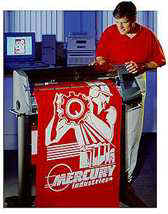
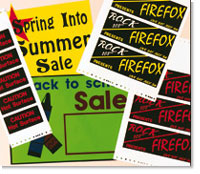


Gerber
High Performance Series 220 Film: PANTONE® Colors Reference Table
We
also offer the Avery Color Selector System for all vinyl graphics. Visit
Avery online to learn more about the color choices available for
your next project!
AVERY
COLOR SELECTOR
Removing
old vinyl decals,
stripes and letters
| In most
instances, it is possible to remove vinyl lettering with no
residual damage to the applied surface. While this is
typically the case, different substrate materials can react in
different ways, so if you're unsure of the resulting reaction,
it's important to test an inconspicuous area of your surface
before applying the following techniques to the entire area.
The upside is that most surfaces, including vehicles, respond
well to the vinyl removal technique outlined below, with no
resulting damage to the surface.
(Note: When working
with decals that have been in place for a significant length
of time, there is the slight possibility that the paint around
the decal will appear discolored or faded upon removal.
Usually this only occurs in cases where the decal has been
exposed to the sun for extreme periods of time. This
significant sun exposure will result in a tan line effect on
the surface, whereby the unexposed area under the decals will
appear nice and shiny next to the faded, exposed surface.)
In the case of an old wooden sign,
where the paint is already chipped and peeling, it is
important to keep in mind that the paint will most likely peel
off with the vinyl letters when you remove them.
|



If you intend to apply new vinyl
to the surface, be sure to clean it thoroughly, then
wipe it down with alcohol to insure that none of the
adhesive remover is left on the surface
|
Heat
the surface of the decal with a heat gun. Then take a
plastic removal squeegee
& scrape vinyl from the surface. See Fig. 1 (Note:
if the vinyl is old & brittle, it will most likely
come off in small pieces. If the vinyl is not that old
you may be able to pull it off in bigger chunks.)
Once you have peeled all of the vinyl off, you will
have to clean the adhesive off the surface with a
product designed to remove adhesive without
damaging the paint. See Fig. 2.
Clean the surface with soap and water then check to
make sure there are no remaining pieces of vinyl or
adhesive stuck to it. See Fig. 3.
|
|
|
|
|
Some
Examples
Of Vinyl Work:
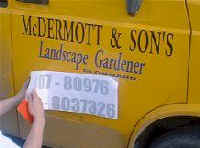
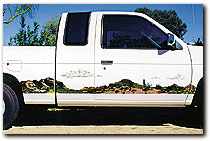
Vehicle Vinyl
Graphics
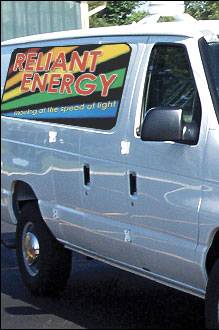
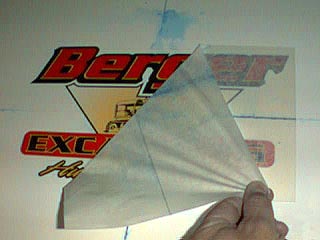
|
Vinyl Graphics - Applying Labels:
- Mix a solution of washing up liquid and water
- Wet the area the sticker will be placed on
- While the surface is still wet, remove the sticker backing and
apply the sticker (the solution will allow you to move the
sticker around)
- Once positioned correctly, use a squeegee or dry cloth to wipe
over the sticker, pushing out any air bubbles
- Once all the water/washing up solution has been removed, pull
off the application tape and your sticker will be left on the
surface
|
| When installing vinyl, it
is important that you apply the product to an adequate
surface, one to which it will readily adhere. The following
lists contain a brief summary of acceptable surfaces along
with some surfaces that are not.
The good news is: Vinyl will stick to
many surfaces. In determining whether your intended surface is
adequate, keep in mind that, as a general rule of thumb, vinyl
will stick to almost any surface that is clean and either
smooth or nonporous.
Acceptable surfaces
- Glass
- Metals (Must be painted with a
smooth, glossy enamel.) One Shot paint recomended.
- Vehicles (Must be painted with a
smooth, glossy enamel.)
- Vinyl (Such as Banners, Canopies,
flags, etc.)
- Plastic
- Fiberglass (Must be painted with a
smooth, glossy enamel.) One Shot paint recomended.
- Wood (Must be painted with a
smooth, glossy enamel.) One Shot paint recomended.
- Other Painted Surfaces (Paint must
be smooth and glossy, vinyl will not stick to oxidized,
faded, or peeling paint) One Shot paint recomended.
Not recommended surfaces
- Cement
- Raw Lumber
- Oxidized or faded paint
- Peeling paint
- Rubber
- Raw Metals
- Oily Surfaces
These lists are not comprehensive and
there are other acceptable and unacceptable substrates than
those listed above. Again, when in doubt, apply the rule that
states vinyl will generally adhere well to smooth, glossy and
clean surfaces. Rough, dull, peeling, porous or dirty
surfaces, on the other hand, will likely not produce an
acceptable vinyl application.
|
|